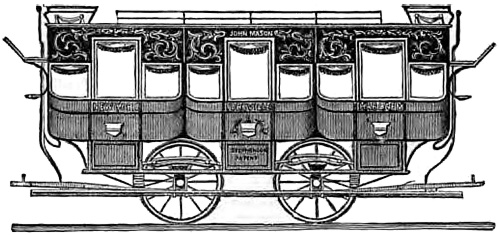The First Street Car
excerpt from Wonders and Curiosities of the Railway (1884)
[p.169] From electrical tramways for cities, we may pass to a consideration of other kinds of city passenger railways. The first street railway in the world was the New York and Harlem, incorporated 1831. The first cars were run in [p.170] November, 1832, from Prince street to Harlem Bridge. These cars were curious structures, from the point of view of people of this generation—being very much like the stage coaches of the time, each having three compartments with side doors; there were leather springs, and the driver sat on an elevated seat in front, and moved the brake with his foot. The car represented in the cut was one of the first two that were built for the Harlem line, and was made by John Stephenson.
The opening of the road, says W.H. Brown, excited a good deal of interest, and the streets along the route were crowded with curious spectators. The bright new car, the “John Mason,” led the way, and the ribbons were handled in gallant style by a well known knight of the whip, named Lank O'Dell, who always drove a pair of gray horses. Both the cars that figured on the occasion contained city officials (the mayor and members of the city council) and invited guests. It was thought by many that there would be great difficulty in stopping the cars quickly enough to avoid accidents to street vehicles. But the vice-president of the road, being very desirous of convincing people how ungrounded were their fears in this regard, determined to give them ocular proof of the ease with which the cars could be brought to a dead stop.
So on the trial day, he posted himself with a number of witnesses somewhere about the corner of the Bowery and Bond street, having previously ordered the drivers of the two cars to watch for his signal, and then stop the cars with all the haste they could. Now, when O'Dell came dashing along, and saw the signal, he easily brought up the car, since he had previously had some experience in hauling materials for the road; but the hackman who drove the second car, forgetting the lever of the brake, only drew hard on his [p.171] lines and shouted, “Whoa!” But in vain; his car slid inexorably forward, and the tongue went crashing through the rear end of the “John Mason,” causing the dignified inmates to beat an unceremonious retreat, amid the laughter of the bystanders. No one was hurt, however, and soon the triumphal train moved on to Harlem Bridge. This is the first street-car collision on record, and it occasioned a good deal of merriment among the citizens, and considerable annoyance to the vice-president; since for several days afterward, the roguishly inclined among his friends would imitate his attitude and gesture on that unlucky street-corner, and raise their arms for him to stop, as he had done to the car-drivers.
The fares were paid in silver sixpences of the old Spanish currency then in circulation. In 1837 the road temporarily succumbed to steam cars, but resumed work in 1845. The old Harlem Railroad Corporation still owns the right of way through the Bowery and Fourth avenue, and receives a large income from the street railroad, as well as from the Hudson River and the New Haven railroads, in return for a cession to them of right of way.
The early street railways of New York were not very popular at first, and were for a time disused. Much of their unpopularity was doubtless due to the objectionable nature of the rail employed; it projected too much above the surface, and was injurious to street vehicles. The first rails were made with grooves, or iron gutters, to guide the wheels. The low step-rail, now everywhere in vogue, was invented and first used in Philadelphia in 1855. In New York the street railway was revived about 1852, by M. Loûbat, a French engineer, who constructed the Sixth Avenue railway in that year. At nearly the same date the Second, Third, and Eighth avenue lines received their [p.172] charters. In 1853 the Cambridge (Massachusetts) horse railroad was chartered, and the Metropolitan of Boston at about the same time (Charles L. Light, engineer). The first car was run out of Boston on the Cambridge road, in April, 1856. By the year 1858 horse railroads were in use in all the large cities of the United States.
[John Mason was a local banker, who founded the Chemical Bank. He was also first president of the New York and Harlem Railroad, which obtained a charter from the city for the street car line. The use of rails reduce friction, which meant the carriage was easier to move, could travel faster, give a smoother ride and carry more passengers. When the company obtained the right-of-way from the city, only the use of horses was permitted, and not a steam-powered vehicle. The city officials made the ceremonial trip on 14 Nov 1832, and public operation began a few days later on 26 Nov 1832. —Webmaster.]





